目录
1)定义理解(自我乱说)
定义:
单向的连接的数据存储结构。
特点:
- 由多个节点通过指针连接而成;只有一个方向;(如图所示)

- 每个节点分为俩个部分,及数据域和指针域;(如图所示)
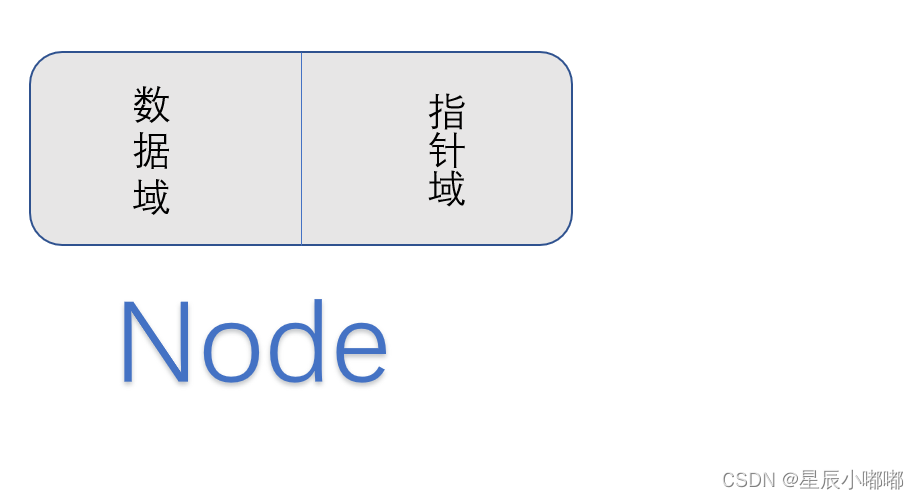
-
数据域
:存储数据,比如放一个或多个整数类型,放一个或多个不同类型数据都行(这里代码演示只放一个int类型,为了方便)。 -
指针域
:存放一个指针,用于指向下一个节点,我愿称它为单链表的脊髓。 -
地址存储特点
:一个节点的数据域和指针域是存储在一个连续的空间上的,一个单链表的不同节点的空间是随机分配的,一般不是连续的空间。(如图所示)
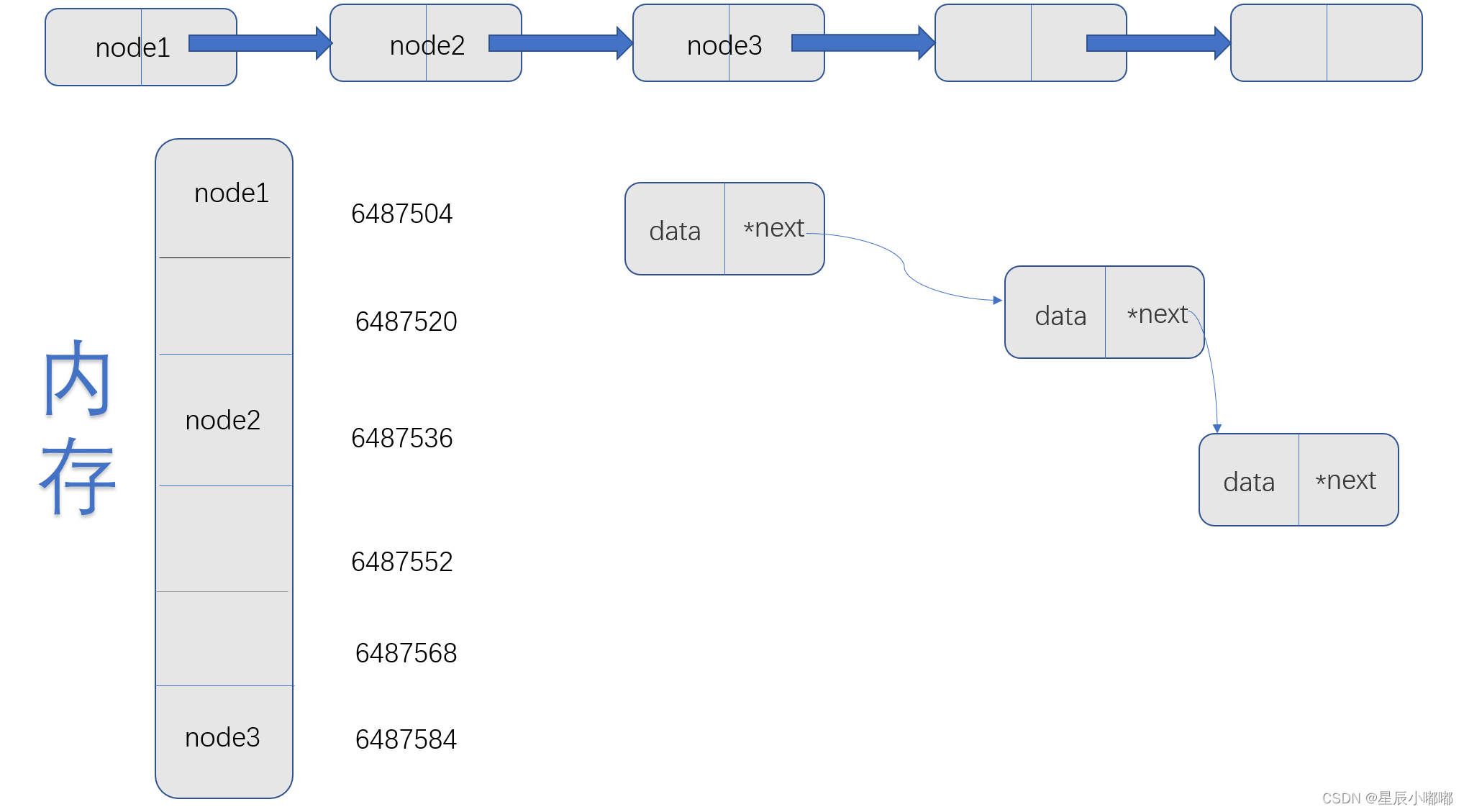
单链表的头尾
对于每个单链表我们会定义一个头指针来指向链表的头部,以后要对单链表进行处理时,给他头指针即可,另外一般我们会把指向NULL的节点称为单链表的尾部,当然我们也可以通过定义一个尾指针来指向尾部。
- 头指针可以是数据域为空的节点指针。
2)代码各功能实现
1.创建节点、头指针、节点指针
代码实现
typedef struct LinkNode{
char data;
struct LinkNode *next;
} LNode, *LinkList, *NodePtr;//节点/链表指针/节点指针
2.创建链表
代码实现
LinkList initLinkList(){
NodePtr tempHeader = (NodePtr)malloc(sizeof(LNode));//申请一个节点大小空间,转化为节点指针类型,用作头
tempHeader->data = '\0';
tempHeader->next = NULL;
return tempHeader;
}
3.从尾巴插入节点
图解
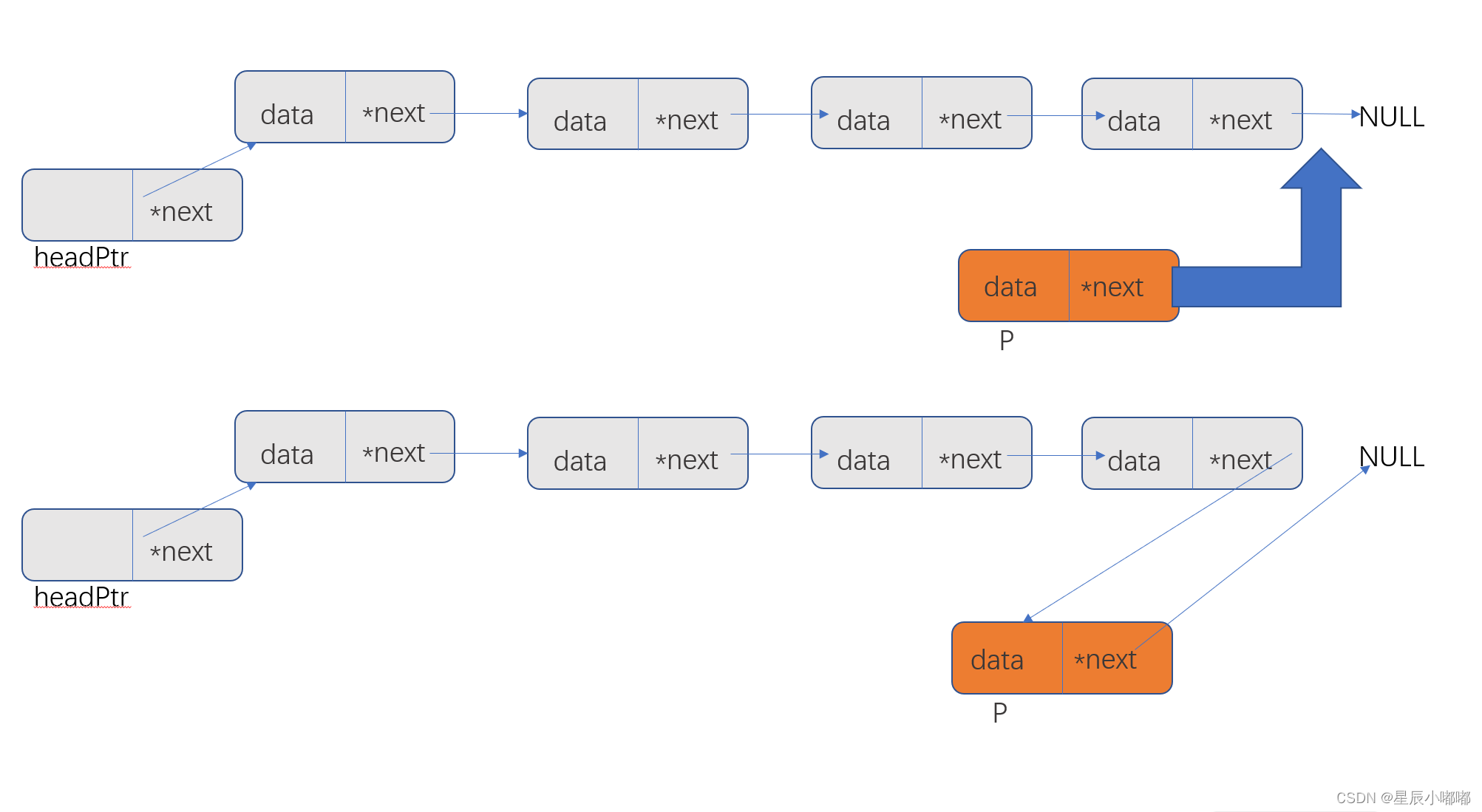
代码实现
void appendElement(NodePtr paraHeader, char paraChar){
NodePtr tempP, tempQ;
//Step 1.Construct a new node.
tempQ = (NodePtr)malloc(sizeof(LNode));
tempQ->data = paraChar;
tempQ->next = NULL;
//Step 2.Search to the tail.
tempP = paraHeader;
while(tempP->next != NULL){
tempP = tempP->next;
}//of while
//Step 3.Now add/link.
tempP->next = tempQ;
}//of appendElement
测试代码
void appendElementTest(){
printf("--- appendElementTest Begin ---\n");
LinkList tempHeader;
tempHeader = initLinkList();
appendElement(tempHeader, 'H');
appendElement(tempHeader, 'E');
appendElement(tempHeader, 'L');
appendElement(tempHeader, 'L');
appendElement(tempHeader, 'O');
appendElement(tempHeader, '!');
printList(tempHeader);
printf("--- appendElementTest Begin ---\n");
}//of appendElementTest
由于每次要去找尾巴,所以创建一个尾指针就很方便。
优化代码
-初始化尾指针
LinkList initTailList(NodePtr paraHeader){
NodePtr tempQ;
tempQ = paraHeader;
while(tempQ->next != NULL){
tempQ = tempQ->next;
}
NodePtr tempTail = (NodePtr)malloc(sizeof(LNode));//申请一个节点大小空间,转化为节点指针类型,用作头
tempTail->next = tempQ;
tempTail->data = '\0';
return tempTail;
}
-尾指针检查
void initTailListTest(){
printf("--- initTailListTest Begin ---\n");
LinkList tempHeader;
tempHeader = initLinkList();
appendElement(tempHeader, 'H');
appendElement(tempHeader, 'E');
appendElement(tempHeader, 'L');
appendElement(tempHeader, 'L');
appendElement(tempHeader, 'O');
appendElement(tempHeader, '!');
printList(tempHeader);
LinkList tempTail = (LinkList)malloc(sizeof(LNode));
tempTail = initTailList(tempHeader);
printf("%c\n", tempTail->next->data);
printf("--- initTailListTest End ---\n");
}void superAppendElement(NodePtr paraTail, char paraChar){
NodePtr tempP;
//Step 1.initialize the p
tempP = (NodePtr)malloc(sizeof(LNode));
tempP->data = paraChar;
//Step 2.insert by the tailPtr
paraTail->next->next = tempP;
tempP->next = NULL;
//Step 3.remake the tailPtr
paraTail->next = tempP;
}
代码测试
void superAppendElementTest(){
printf("--- superAppendElementTest Begin ---\n");
LinkList tempHeader, tempTail;
tempHeader = initLinkList();
tempTail = initTailList(tempHeader);
superAppendElement(tempTail, 'H');
superAppendElement(tempTail, 'E');
superAppendElement(tempTail, 'L');
superAppendElement(tempTail, 'L');
superAppendElement(tempTail, 'O');
superAppendElement(tempTail, '!');
superAppendElement(tempTail, ' ');
superAppendElement(tempTail, 'W');
printList(tempHeader);
printf("--- superAppendElementTest End ---\n");
}
4.按照指定位置插入
图解
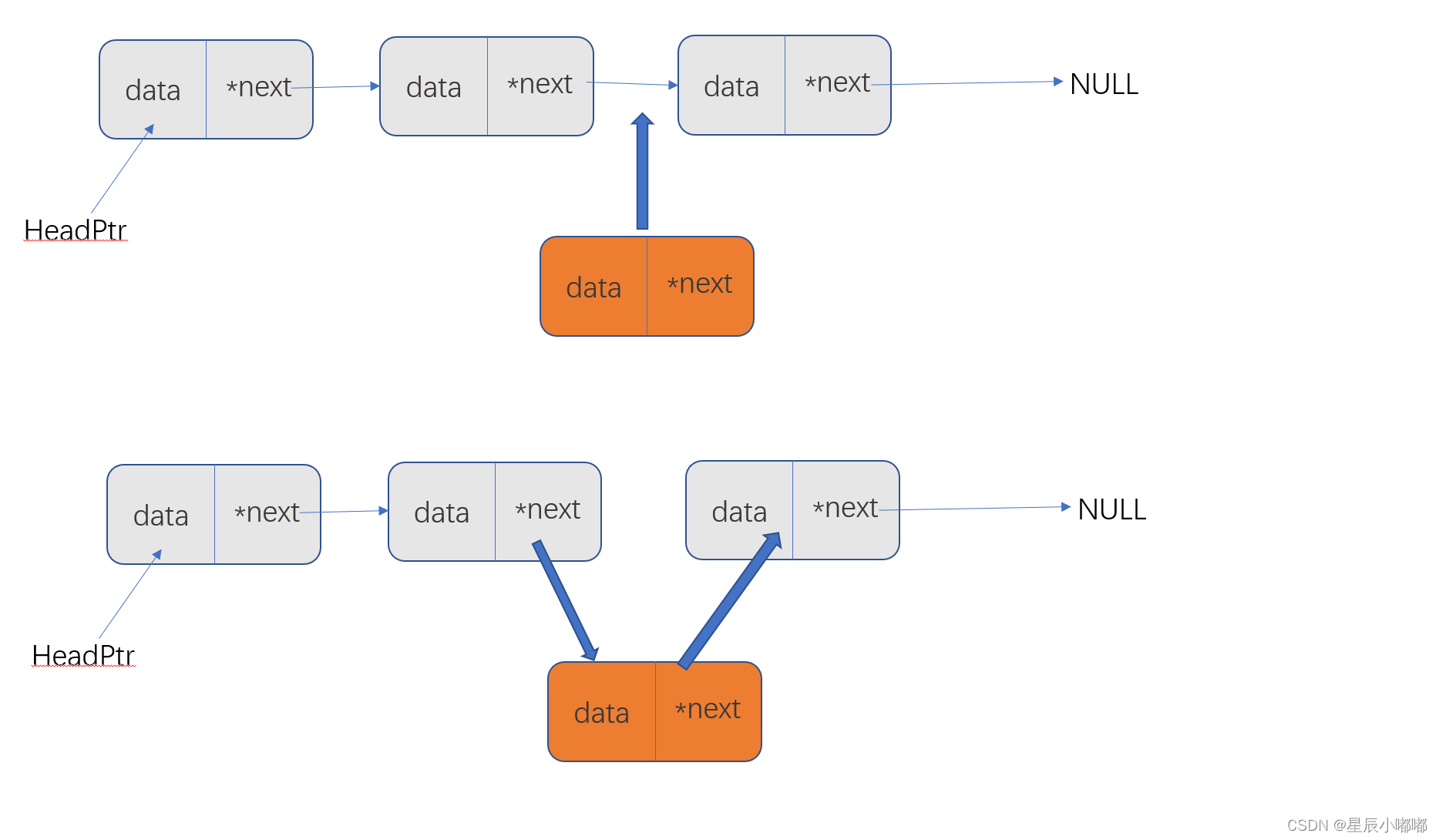
代码实现
void insertElement(NodePtr paraHeader, char paraChar, int paraPosition){
NodePtr tempP, tempQ;
//Step 1.Search to the position
tempP = paraHeader;
for (int i = 0; i < paraPosition - 1; i++){
tempP = tempP->next;
if(tempP == NULL){
printf("The position %d is beyond the scope of the list.", paraPosition);
}//of if
}//of for
//Step 2.Construct a new node.
tempQ = initLinkList();
tempQ->data = paraChar;
//Step 3.Now link.
printf("linking\r\n");
tempQ->next = tempP->next;
tempP->next = tempQ;
}//of InsertElenment
测试代码
void insertElementTest(){
printf("--- insertElementTest Begin ---\n");
//initialize.
LinkList tempList;
tempList = initLinkList();
appendElement(tempList, 'H');
appendElement(tempList, 'E');
appendElement(tempList, 'L');
appendElement(tempList, 'L');
appendElement(tempList, 'O');
appendElement(tempList, '!');
printList(tempList);
//insert in firt
insertElement(tempList, '0', 1);
//insert in 3
insertElement(tempList, '0', 3);
//insert in last
insertElement(tempList, '0', 9);
printList(tempList);
printf("--- insertElementTest End ---\n");
}
5.按照给定数据插入
图解
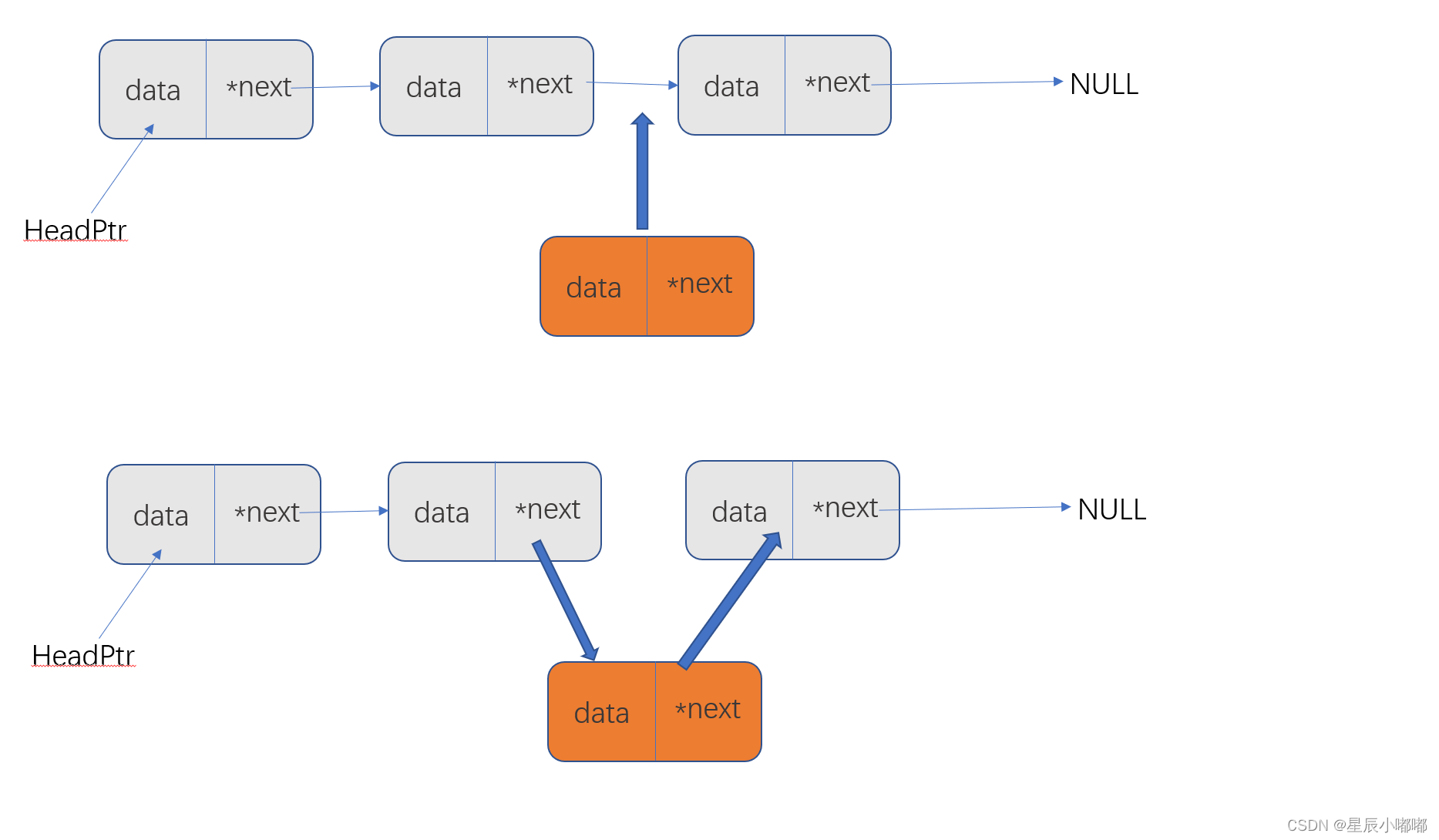
代码实现
void insertElement1(NodePtr paraHeader, char paraChar, char paraGivenChar){
NodePtr tempP, tempQ;
//Step 1.Search to the position
tempP = paraHeader;
while(tempP->next->data != paraGivenChar){
tempP = tempP->next;
if(tempP == NULL){
printf("The data %c is beyond the scope of the list.", paraGivenChar);
}//of if
}//of while
tempQ = (NodePtr)malloc(sizeof(LNode));
tempQ->data = paraChar;
//Step 2.insert
tempQ->next = tempP->next;
tempP->next = tempQ;
}
测试代码
void insertElementTest1(){
printf("--- insertElementTest1 Begin ---\n");
//initialize.
LinkList tempList;
tempList = initLinkList();
appendElement(tempList, 'H');
appendElement(tempList, 'E');
appendElement(tempList, 'L');
appendElement(tempList, 'L');
appendElement(tempList, 'O');
appendElement(tempList, '!');
printList(tempList);
//insert before H
insertElement1(tempList, '0', 'H');
//insert before E
insertElement1(tempList, '0', 'E');
//insert before !
insertElement1(tempList, '0', '!');
printList(tempList);
printf("--- insertElementTest1 End ---\n");
}
6.删除指定数据节点
图解
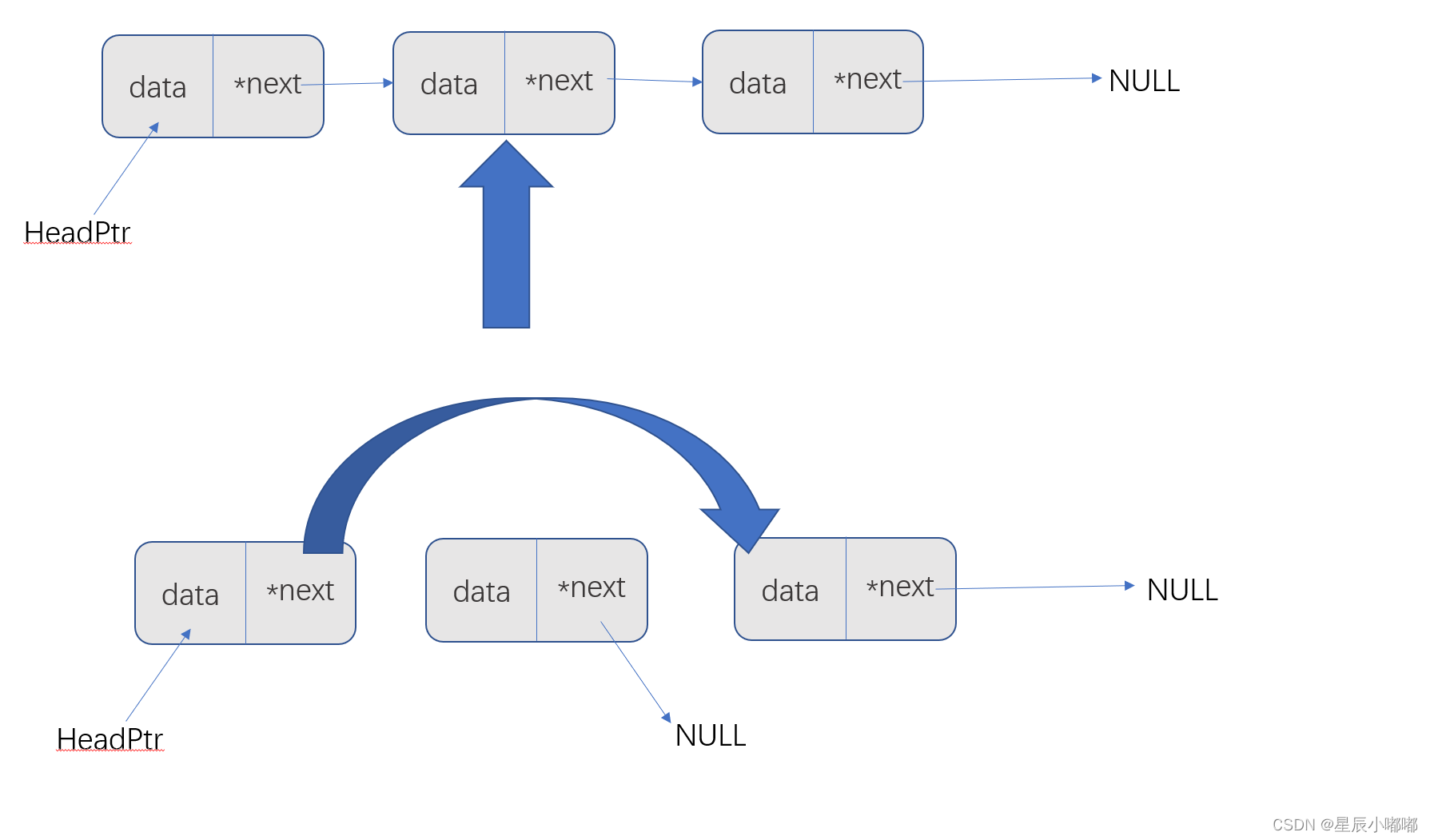
代码实现
void deleteElement(NodePtr paraHeader, char paraChar){
NodePtr tempP, tempQ;
tempP = paraHeader;
//Step 1.Search to the position
while((tempP->next->data != paraChar) && (tempP->next != NULL)){
tempP = tempP->next;
}// of While
if(tempP->next == NULL){
printf("there is no the value!");
return;
}//of if
//Step 2.Delete
tempQ = tempP->next;
tempP->next = tempP->next->next;
free(tempQ);
} //of Delete
代码测试
void deleteElementTest(){
printf("--- deleteElementTest Begin ---\n");
//Initialize.
LinkList tempList;
tempList = initLinkList();
appendElement(tempList, 'H');
appendElement(tempList, 'E');
appendElement(tempList, 'L');
appendElement(tempList, 'L');
appendElement(tempList, 'O');
appendElement(tempList, '!');
printList(tempList);
//delete the 'H'
deleteElement(tempList, 'H');
printList(tempList);
//delete the 'L'(first)
deleteElement(tempList, 'L');
printList(tempList);
//delete the '!'
deleteElement(tempList, '!');
printList(tempList);
printf("--- deleteElementTest End ---\n");
}
7.求前驱
代码实现
NodePtr getPriorNode(NodePtr paraHeader, char paraGivenChar){
NodePtr tempP;
tempP = paraHeader;
//seek the target data
while(tempP->next->data != paraGivenChar){
tempP = tempP->next;
if(tempP == NULL){
printf("no prior", paraGivenChar);
return Emp;
}//of if
}//of while
//if it is first , it has no proir
if(tempP == paraHeader ){
printf("no prior");
return Emp;
}
return tempP;
}
测试代码
NodePtr getPriorNodeTest(){
printf("--- getPriorNodeTest Begin ---\n");
//initialize.
LinkList tempList;
tempList = initLinkList();
appendElement(tempList, 'H');
appendElement(tempList, 'E');
appendElement(tempList, 'L');
appendElement(tempList, 'L');
appendElement(tempList, 'O');
appendElement(tempList, '!');
printList(tempList);
NodePtr tempP;
//firt node
tempP = getPriorNode(tempList, 'H');
printf("%c\n", tempP->data);
//second node
tempP = getPriorNode(tempList, 'E');
printf("%c\n", tempP->data);
//last node
tempP = getPriorNode(tempList, '!');
printf("%c\n", tempP->data);
printf("--- getPriorNodeTest End ---\n");
}
8.求指定数据类型最大值
代码实现
char getMaxData(NodePtr paraHeader){
NodePtr tempP = paraHeader;
//if empty
if(paraHeader->next == NULL){
printf("no data");
return '\0';
}
char max = tempP -> data;
while(tempP->next != NULL){
tempP = tempP->next;
if(tempP->data > max ){
max = tempP->data;
}
}
return max;
}
测试代码
void getMaxDataTest(){
printf("--- getMaxDataTest Begin ---\n");
//Initialize.
LinkList tempList;
tempList = initLinkList();
appendElement(tempList, '1');
appendElement(tempList, '9');
appendElement(tempList, '3');
appendElement(tempList, '0');
appendElement(tempList, '1');
appendElement(tempList, '5');
printList(tempList);
char max = getMaxData(tempList);
printf("%c\n", max);
printf("--- getMaxDataTest End ---\n");
}
9.清空单链表
代码实现:
void destroyList(NodePtr paraHeader){
paraHeader->next = NULL;
}
代码测试
void destroyListTest(){
printf("--- destroyListTest Begin ---\n");
//initialize.
LinkList tempList;
tempList = initLinkList();
appendElement(tempList, 'H');
appendElement(tempList, 'E');
appendElement(tempList, 'L');
appendElement(tempList, 'L');
appendElement(tempList, 'O');
appendElement(tempList, '!');
printList(tempList);
//destroy
destroyList(tempList);
printList(tempList);
printf("--- destroyListTest End ---\n");
}
3)地址访问
代码实现:
void basicAddressTest(){
printf("--- basicAddressTest begin ---\n");
LNode tempList1, tempList2, tempList3;
tempList1.data = 4;
tempList1.next = NULL;
tempList2.data = 6;
tempList2.next = NULL;
tempList3.data = 8;
tempList3.next = NULL;
int *p = NULL;
typedef struct LinkNode2{
char data;
}LNode2;
typedef struct LinkNode3{
struct LinkNode3 *next;
}LNode3;
printf("the sizeof of the LNode2: %d\n", sizeof(LNode2));
printf("the sizeof of the LNode3: %d\n", sizeof(LNode3));
printf("the sizeof of the LNode: %d\n", sizeof(LNode));
printf("the sizeof of the LinkList: %d\n", sizeof(LinkList));
printf("the sizeof of the int *p: %d\n", sizeof(p));
printf("The first list: %d %d %d\n", &tempList1, &tempList1.data, &tempList1.next);
printf("The second list: %d %d %d\n", &tempList2, &tempList2.data, &tempList2.next);
printf("The third list: %d %d %d\n", &tempList3, &tempList3.data, &tempList3.next);
printf("--- basicAddressTest end ---\n");
}
结果:
— basicAddressTest begin —
the sizeof of the LNode2: 1
the sizeof of the LNode3: 8
the sizeof of the LNode: 16
the sizeof of the LinkList: 8
the sizeof of the int *p: 8
The first list: 6487504 6487504 6487512
The second list: 6487488 6487488 6487496
The third list: 6487472 6487472 6487480
— basicAddressTest end —
思考:
一个节点内储存的空间是连续的, 但俩个连续的节点的空间储存上不是连续的,所以指针是单向通道。
4)总结:
上面的定义就是我对链表的理解;
主要是搞清楚头指针是上面,里面的作用就能看懂单链表。
5)总代码:
#include <stdio.h>
#include <malloc.h>
/**
* Linked list of characters. The key is data.
*/
typedef struct LinkNode{
char data;
struct LinkNode *next;
} LNode, *LinkList, *NodePtr;//节点/链表指针/节点指针
static NodePtr Emp = (NodePtr)malloc(sizeof(LNode));//empty node
void initEmptyNode(){
Emp->data = '\0';
Emp->next = NULL;
}
/**
* Initialize the list with a header.
* @return The Pointer to the header.
*/
LinkList initLinkList(){
NodePtr tempHeader = (NodePtr)malloc(sizeof(LNode));//申请一个节点大小空间,转化为节点指针类型,用作头
tempHeader->data = '\0';
tempHeader->next = NULL;
return tempHeader;
}
/**
* Print the list
* @param paraHead The header of teh List
*/
void printList(NodePtr paraHeader){
NodePtr tempP = paraHeader->next;//skip headPtr,no data in headPtr
if(tempP == NULL){
printf("The LinkList is empty");
printf("\r\n");
return;
}
while(tempP != NULL){
printf("%c", tempP->data);
tempP = tempP->next;
}
printf("\r\n");
}
/**
* Add an element to the tail.
* @param paraHeader The header of the list.
* @param paraChar The give cahr.
*/
void appendElement(NodePtr paraHeader, char paraChar){
NodePtr tempP, tempQ;
//Step 1.Construct a new node.
tempQ = (NodePtr)malloc(sizeof(LNode));
tempQ->data = paraChar;
tempQ->next = NULL;
//Step 2.Search to the tail.
tempP = paraHeader;
while(tempP->next != NULL){
tempP = tempP->next;
}//of while
//Step 3.Now add/link.
tempP->next = tempQ;
}//of appendElement
void appendElementTest(){
printf("--- appendElementTest Begin ---\n");
LinkList tempHeader;
tempHeader = initLinkList();
appendElement(tempHeader, 'H');
appendElement(tempHeader, 'E');
appendElement(tempHeader, 'L');
appendElement(tempHeader, 'L');
appendElement(tempHeader, 'O');
appendElement(tempHeader, '!');
printList(tempHeader);
printf("--- appendElementTest Begin ---\n");
}//of appendElementTest
LinkList initTailList(NodePtr paraHeader){
NodePtr tempQ;
tempQ = paraHeader;
while(tempQ->next != NULL){
tempQ = tempQ->next;
}
NodePtr tempTail = (NodePtr)malloc(sizeof(LNode));//申请一个节点大小空间,转化为节点指针类型,用作头
tempTail->next = tempQ;
tempTail->data = '\0';
return tempTail;
}
void initTailListTest(){
printf("--- initTailListTest Begin ---\n");
LinkList tempHeader;
tempHeader = initLinkList();
appendElement(tempHeader, 'H');
appendElement(tempHeader, 'E');
appendElement(tempHeader, 'L');
appendElement(tempHeader, 'L');
appendElement(tempHeader, 'O');
appendElement(tempHeader, '!');
printList(tempHeader);
LinkList tempTail = (LinkList)malloc(sizeof(LNode));
tempTail = initTailList(tempHeader);
printf("%c\n", tempTail->next->data);
printf("--- initTailListTest End ---\n");
}
void superAppendElement(NodePtr paraTail, char paraChar){
NodePtr tempP;
//Step 1.initialize the p
tempP = (NodePtr)malloc(sizeof(LNode));
tempP->data = paraChar;
//Step 2.insert by the tailPtr
paraTail->next->next = tempP;
tempP->next = NULL;
//Step 3.remake the tailPtr
paraTail->next = tempP;
}
void superAppendElementTest(){
printf("--- superAppendElementTest Begin ---\n");
LinkList tempHeader, tempTail;
tempHeader = initLinkList();
tempTail = initTailList(tempHeader);
superAppendElement(tempTail, 'H');
superAppendElement(tempTail, 'E');
superAppendElement(tempTail, 'L');
superAppendElement(tempTail, 'L');
superAppendElement(tempTail, 'O');
superAppendElement(tempTail, '!');
superAppendElement(tempTail, ' ');
superAppendElement(tempTail, 'W');
printList(tempHeader);
printf("--- superAppendElementTest End ---\n");
}
/**
* Insert an element to the given position.
* @param paraHeader The header of the list.
* @param paraChar The give cahr.
* @param paraPostion The given position.
*/
void insertElement(NodePtr paraHeader, char paraChar, int paraPosition){
NodePtr tempP, tempQ;
//Step 1.Search to the position
tempP = paraHeader;
for (int i = 0; i < paraPosition - 1; i++){
tempP = tempP->next;
if(tempP == NULL){
printf("The position %d is beyond the scope of the list.", paraPosition);
}//of if
}//of for
//Step 2.Construct a new node.
tempQ = initLinkList();
tempQ->data = paraChar;
//Step 3.Now link.
printf("linking\r\n");
tempQ->next = tempP->next;
tempP->next = tempQ;
}//of InsertElenment
void insertElementTest(){
printf("--- insertElementTest Begin ---\n");
//initialize.
LinkList tempList;
tempList = initLinkList();
appendElement(tempList, 'H');
appendElement(tempList, 'E');
appendElement(tempList, 'L');
appendElement(tempList, 'L');
appendElement(tempList, 'O');
appendElement(tempList, '!');
printList(tempList);
//insert in firt
insertElement(tempList, '0', 1);
//insert in 3
insertElement(tempList, '0', 3);
//insert in last
insertElement(tempList, '0', 9);
printList(tempList);
printf("--- insertElementTest End ---\n");
}
/**
* Insert an element to the given position.
* @param paraHeader The header of the list.
* @param paraChar The give cahr.
* @param paraPostion The given data.
*/
void insertElement1(NodePtr paraHeader, char paraChar, char paraGivenChar){
NodePtr tempP, tempQ;
//Step 1.Search to the position
tempP = paraHeader;
while(tempP->next->data != paraGivenChar){
tempP = tempP->next;
if(tempP == NULL){
printf("The data %c is beyond the scope of the list.", paraGivenChar);
}//of if
}//of while
tempQ = (NodePtr)malloc(sizeof(LNode));
tempQ->data = paraChar;
//Step 2.insert
tempQ->next = tempP->next;
tempP->next = tempQ;
}
void insertElementTest1(){
printf("--- insertElementTest1 Begin ---\n");
//initialize.
LinkList tempList;
tempList = initLinkList();
appendElement(tempList, 'H');
appendElement(tempList, 'E');
appendElement(tempList, 'L');
appendElement(tempList, 'L');
appendElement(tempList, 'O');
appendElement(tempList, '!');
printList(tempList);
//insert before H
insertElement1(tempList, '0', 'H');
//insert before E
insertElement1(tempList, '0', 'E');
//insert before !
insertElement1(tempList, '0', '!');
printList(tempList);
printf("--- insertElementTest1 End ---\n");
}
/**
* Delete an element from the list.
* @param paraHeader The header of list.
* @param paraChar The given char.
*/
void deleteElement(NodePtr paraHeader, char paraChar){
NodePtr tempP, tempQ;
tempP = paraHeader;
//Step 1.Search to the position
while((tempP->next->data != paraChar) && (tempP->next != NULL)){
tempP = tempP->next;
}// of While
if(tempP->next == NULL){
printf("there is no the value!");
return;
}//of if
//Step 2.Delete
tempQ = tempP->next;
tempP->next = tempP->next->next;
free(tempQ);
} //of Delete
void deleteElementTest(){
printf("--- deleteElementTest Begin ---\n");
//Initialize.
LinkList tempList;
tempList = initLinkList();
appendElement(tempList, 'H');
appendElement(tempList, 'E');
appendElement(tempList, 'L');
appendElement(tempList, 'L');
appendElement(tempList, 'O');
appendElement(tempList, '!');
printList(tempList);
//delete the 'H'
deleteElement(tempList, 'H');
printList(tempList);
//delete the 'L'(first)
deleteElement(tempList, 'L');
printList(tempList);
//delete the '!'
deleteElement(tempList, '!');
printList(tempList);
printf("--- deleteElementTest End ---\n");
}
/**
* get an priorElement from the list.
* @param paraHeader The header of list.
* @param paraChar The given char.
*/
NodePtr getPriorNode(NodePtr paraHeader, char paraGivenChar){
NodePtr tempP;
tempP = paraHeader;
//seek the target data
while(tempP->next->data != paraGivenChar){
tempP = tempP->next;
if(tempP == NULL){
printf("no prior", paraGivenChar);
return Emp;
}//of if
}//of while
//if it is first , it has no proir
if(tempP == paraHeader ){
printf("no prior");
return Emp;
}
return tempP;
}
NodePtr getPriorNodeTest(){
printf("--- getPriorNodeTest Begin ---\n");
//initialize.
LinkList tempList;
tempList = initLinkList();
appendElement(tempList, 'H');
appendElement(tempList, 'E');
appendElement(tempList, 'L');
appendElement(tempList, 'L');
appendElement(tempList, 'O');
appendElement(tempList, '!');
printList(tempList);
NodePtr tempP;
//firt node
tempP = getPriorNode(tempList, 'H');
printf("%c\n", tempP->data);
//second node
tempP = getPriorNode(tempList, 'E');
printf("%c\n", tempP->data);
//last node
tempP = getPriorNode(tempList, '!');
printf("%c\n", tempP->data);
printf("--- getPriorNodeTest End ---\n");
}
//some interesting thing
void basicAddressTest(){
printf("--- basicAddressTest begin ---\n");
LNode tempList1, tempList2, tempList3;
tempList1.data = 4;
tempList1.next = NULL;
tempList2.data = 6;
tempList2.next = NULL;
tempList3.data = 8;
tempList3.next = NULL;
int *p = NULL;
typedef struct LinkNode2{
char data;
}LNode2;
typedef struct LinkNode3{
struct LinkNode3 *next;
}LNode3;
printf("the sizeof of the LNode2: %d\n", sizeof(LNode2));
printf("the sizeof of the LNode3: %d\n", sizeof(LNode3));
printf("the sizeof of the LNode: %d\n", sizeof(LNode));
printf("the sizeof of the LinkList: %d\n", sizeof(LinkList));
printf("the sizeof of the int *p: %d\n", sizeof(p));
printf("The first list: %d %d %d\n", &tempList1, &tempList1.data, &tempList1.next);
printf("The second list: %d %d %d\n", &tempList2, &tempList2.data, &tempList2.next);
printf("The third list: %d %d %d\n", &tempList3, &tempList3.data, &tempList3.next);
printf("--- basicAddressTest end ---\n");
}
/**
* get the max data from the list.
* @param paraHeader The header of list.
* @return max.
*/
char getMaxData(NodePtr paraHeader){
NodePtr tempP = paraHeader;
//if empty
if(paraHeader->next == NULL){
printf("no data");
return '\0';
}
char max = tempP -> data;
while(tempP->next != NULL){
tempP = tempP->next;
if(tempP->data > max ){
max = tempP->data;
}
}
return max;
}
void getMaxDataTest(){
printf("--- getMaxDataTest Begin ---\n");
//Initialize.
LinkList tempList;
tempList = initLinkList();
appendElement(tempList, '1');
appendElement(tempList, '9');
appendElement(tempList, '3');
appendElement(tempList, '0');
appendElement(tempList, '1');
appendElement(tempList, '5');
printList(tempList);
char max = getMaxData(tempList);
printf("%c\n", max);
printf("--- getMaxDataTest End ---\n");
}
/**
* Destroy list.
* @param paraHeader The header of list.
*/
void destroyList(NodePtr paraHeader){
paraHeader->next = NULL;
}
void destroyListTest(){
printf("--- destroyListTest Begin ---\n");
//initialize.
LinkList tempList;
tempList = initLinkList();
appendElement(tempList, 'H');
appendElement(tempList, 'E');
appendElement(tempList, 'L');
appendElement(tempList, 'L');
appendElement(tempList, 'O');
appendElement(tempList, '!');
printList(tempList);
//destroy
destroyList(tempList);
printList(tempList);
printf("--- destroyListTest End ---\n");
}
int main()
{
initEmptyNode();
appendElementTest();
insertElementTest();
deleteElementTest();
basicAddressTest();
superAppendElementTest();
initTailListTest();
insertElementTest1();
getPriorNodeTest();
getMaxDataTest();
destroyListTest();
return 0;
}